A Window into Nashville's Soul
In image and word, Bob Schatz and Christine Kreyling explore Nashville’s architectural riches

In his introduction to Nashville by Design: Architectural Treasures, Governor Phil Bredesen writes that a “city’s architecture is a window into its soul.” This notion—that a city is a living thing animated by a unique spirit—seems to have guided photographer Bob Schatz and design critic Christine Kreyling as they put together this tribute to the gems of Nashville architecture. Kreyling, author of The Plan of Nashville, has also written award-winning articles for the Nashville Scene. Schatz, whose work is in the permanent collections of Cheekwood, the Tennessee State Museum, and the Frist Center for the Visual Arts, is known for his striking architectural images. Their combined expertise results in a book that is both beautiful and rich with the lore of Nashville’s great buildings. It provides an intimate, sometimes surprising portrait of the city’s exceptional spaces.
Schatz notes in the preface to Nashville by Design that the book is not an “academic survey” of Nashville’s architecture, but rather a collection of personal favorites that includes both landmark buildings and “special spaces, some rarely seen.” In the latter category are private homes like Deepwood, a modernist house in Forest Hills designed by Nashvillian Edwin Keeble in 1936. A stunning white structure surrounded by trees, Deepwood has the “effect of abstract sculpture,” according to Kreyling. At the opposite end of the home design spectrum is Locust Hill, a deliberately plain, Federal-style house built in 1805 that gains its warm beauty from handmade brick and extensive woodwork. Schatz captures the character of the houses by focusing on the geometry of their interiors, giving a sense of how it might feel to inhabit them.
 He takes a different approach when photographing familiar public spaces. The Tennessee State Capitol, the Parthenon, The Downtown Presbyterian Church, and the L&C Tower are among the familiar landmarks on which he turns his camera. Rather than celebrating their grandeur, Schatz more often focuses on the beauty of their details, such as the elaborate carvings adorning the pews of Christ Church Cathedral, or the Capitol’s richly ornamented ceilings. Kreyling contributes lively mini-histories that explain Nashville’s quirkier landmarks, including the “Karnak on the Cumberland”—otherwise known as the Downtown Presbyterian Church, an Egyptian Revival oddity designed by William Strickland.
He takes a different approach when photographing familiar public spaces. The Tennessee State Capitol, the Parthenon, The Downtown Presbyterian Church, and the L&C Tower are among the familiar landmarks on which he turns his camera. Rather than celebrating their grandeur, Schatz more often focuses on the beauty of their details, such as the elaborate carvings adorning the pews of Christ Church Cathedral, or the Capitol’s richly ornamented ceilings. Kreyling contributes lively mini-histories that explain Nashville’s quirkier landmarks, including the “Karnak on the Cumberland”—otherwise known as the Downtown Presbyterian Church, an Egyptian Revival oddity designed by William Strickland.
“Architecture doesn’t move, but it is certainly not static,” writes Schatz in the book’s preface, and that observation is borne out in his photographs, which explore the endless interplay of light and line in the buildings that give Nashville its unique visage. Kreyling’s text likewise confirms that Nashville’s remarkable structures are continually evolving along with its culture, providing a glimpse of the city’s living soul.


